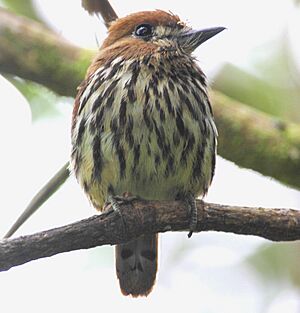Lanceolated monklet facts for kids
Quick facts for kids Lanceolated monklet |
|
|---|---|
 |
|
| Peru | |
| Conservation status | |
| Scientific classification | |
 |
The lanceolated monklet (Micromonacha lanceolata) is a small, unique bird. It belongs to the Bucconidae family, which includes puffbirds and nunbirds. You can find this bird in several countries in Central and South America. These include Bolivia, Brazil, Colombia, Costa Rica, Ecuador, Panama, and Peru.
Contents
About the Lanceolated Monklet
The lanceolated monklet is the only bird of its kind in its group, called a genus. It's also the only bird known as a "monklet"! Even though some people have wondered if the birds in Costa Rica and Panama are a different type, they are all considered the same species.
What Does It Look Like?
The lanceolated monklet is a small bird, about 13 to 15 centimeters (5 to 6 inches) long. It weighs around 19 to 22 grams (0.7 to 0.8 ounces). This bird is mostly warm brown all over. It has cool, scale-like markings that are a light yellowish-brown color on its back.
It has white, stiff feathers around its large bill. These look like bristles. It also has white "whiskers," which are actually tufts of soft feathers. There are white patches near its eyes and a white half-ring behind each eye. Its wings and the top of its tail are dark brown. The underside of its tail is gray. Most of its belly is white with strong black streaks. The very middle of its belly is plain white, and the area near its tail has a yellowish-orange tint.
Where Does It Live?
The lanceolated monklet lives in different areas that are not connected. One area is on the Caribbean side of Costa Rica and into western Panama. Another area stretches from west-central Colombia down to west-central Ecuador. The biggest area covers eastern Ecuador, southern Colombia, western Brazil, and eastern Peru. You can also find it in a few spots in Bolivia.
This bird likes many types of places. It lives at the edges of old forests and in natural clearings. It also likes mature younger forests, small groups of trees, and coffee farms that have shade trees. It can be found in both lowland and mountain evergreen forests. It usually stays in the middle or upper parts of the trees. It mostly lives at elevations between 300 and 1500 meters (980 to 4,900 feet) high. Sometimes, it can be found as high as 2100 meters (6,900 feet).
Monklet Behavior
What Do They Eat?
The lanceolated monklet is a hunter! It usually waits on a branch, about 4 to 8 meters (13 to 26 feet) off the ground. From there, it quickly flies out to catch insects. It also enjoys eating berries. Sometimes, it joins groups of different bird species that are hunting together.
Reproduction and Nests
Scientists have found one lanceolated monklet nest. It was inside a small room at the end of a 40-centimeter (16-inch) long tunnel. This tunnel was dug into an earthen bank. The mother bird laid two white eggs on a bed of dry leaves.
What Do They Sound Like?
The lanceolated monklet has a special song. It's a series of 1 to 5 high, thin, and sad-sounding whistles. They rise in pitch, like "sewee ... sewee sewee-sewee-sewee’swee’swee." Each whistle is a little higher than the one before it. When they want to talk to each other, they make a thin, high-pitched "tsip tsip" sound.
Conservation Status
The IUCN (International Union for Conservation of Nature) keeps track of how many animals are left. In 1988, they thought the lanceolated monklet was "Near Threatened." This meant it might be at risk soon. But since 2004, they have changed its status to "Least Concern." This is good news!
The bird lives across a very large area. Experts believe there are more than 50,000 adult monklets. However, this number might be slowly going down. The bird seems to be rare in some places and quite common in others. It might be hard to find, so there could be more of them than we know!


